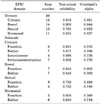1. Ministry of Health and Welfare. Annual report of Korea central cancer registry. 2005. 11–24.
2. Jemal A, Siegel R, Ward E, Hao Y, Xu J, Murray T, et al. Cancer statistics, 2008. CA Cancer J Clin. 2008. 58:71–96.
3. Wilt TJ, MacDonald R, Rutks I, Shamliyan TA, Taylor BC, Kane RL. Systematic review: comparative effectiveness and harms of treatments for clinically localized prostate cancer. Ann Intern Med. 2008. 148:435–448.
4. Zeliadt SB, Moinpour CM, Blough DK, Penson DF, Hall IJ, Smith JL, et al. Preliminary treatment considerations among men with newly diagnosed prostate cancer. Am J Manag Care. 2010. 16:e121–e130.
5. Litwin MS, Hays RD, Fink A, Ganz PA, Leake B, Brook RH. The UCLA Prostate Cancer Index: development, reliability, and validity of a health-related quality of life measure. Med Care. 1998. 36:1002–1012.
6. Wei JT, Dunn RL, Litwin MS, Sandler HM, Sanda MG. Development and validation of the expanded prostate cancer index composite (EPIC) for comprehensive assessment of health-related quality of life in men with prostate cancer. Urology. 2000. 56:899–905.
7. Thompson I, Thrasher JB, Aus G, Burnett AL, Canby-Hagino ED, Cookson MS, et al. Guideline for the management of clinically localized prostate cancer: 2007 update. J Urol. 2007. 177:2106–2131.
8. Chung TG, Lee TK, Chung S, Lee MS, Kim YS, Ahn TY. The Korean version of the International Index of Erectile Function (IIEF): reliability and validation study. Korean J Urol. 1999. 40:1334–1343.
11. Penson DF, Litwin MS, Aaronson NK. Health related quality of life in men with prostate cancer. J Urol. 2003. 169:1653–1661.
12. Efficace F, Bottomley A, van Andel G. Health related quality of life in prostate carcinoma patients: a systematic review of randomized controlled trials. Cancer. 2003. 97:377–388.
13. Moul JW, Anderson J, Penson DF, Klotz LH, Soloway MS, Schulman CC. Early prostate cancer: prevention, treatment modalities, and quality of life issues. Eur Urol. 2003. 44:283–293.
14. Heidenreich A. Guidelines and counselling for treatment options in the management of prostate cancer. Recent Results Cancer Res. 2007. 175:131–162.
15. Kumar RJ, Barqawi A, Crawford ED. Adverse events associated with hormonal therapy for prostate cancer. Rev Urol. 2005. 7:Suppl 5. S37–S43.
16. Hong JH, Jeon SS, Lee HM, Choi YH, Kim S, Choi HY. The Functional Assessment of Cancer Therapy-Prostate (FACT-P) scales in men with prostate cancer: reliability and validity of the Korean version. J Korean Med Sci. 2006. 21:295–299.
17. Anderson JF, Swanson DA, Levy LB, Kuban DA, Lee AK, Kudchadker R, et al. Urinary side effects and complications after permanent prostate brachytherapy: the MD Anderson Cancer Center experience. Urol. 2009. 74:601–605.
18. Takegami M, Suzukamo Y, Sanda MG, Kamoto T, Namiki S, Arai Y, et al. The Japanese translation and cultural adaptation of Expanded Prostate Cancer Index Composite (EPIC). Nippon Hinyokika Gakkai Zasshi. 2005. 96:657–669.
19. Ferrer M, Garin O, Pera J, Prats JM, Mendivil J, Alonso J, et al. Evaluation of the quality of patients with localized prostate cancer: validation of the Spanish version of the EPIC. Med Clin (Barc). 2009. 132:128–135.
20. Korfage IJ, Roobol M, de Koning HJ, Kirkels WJ, Schröder FH, Essink-Bot ML. Does "normal" aging imply urinary, bowel, and erectile dysfunction? A general population survey. Urology. 2008. 72:3–9.








 PDF
PDF ePub
ePub Citation
Citation Print
Print


 XML Download
XML Download